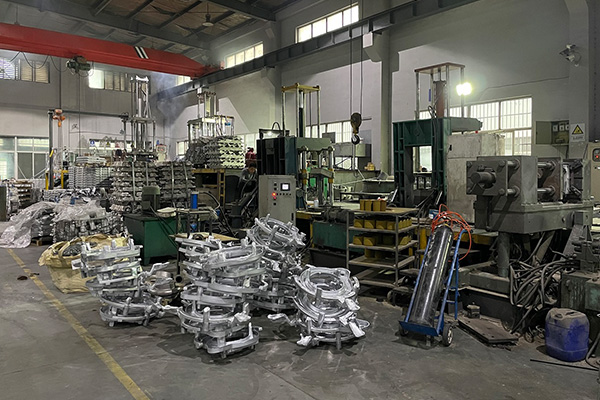Here's a detailed comparison of the three methods for casting aluminum: die casting, sand casting, and permanent mold casting.
- Die Casting: Die casting is a high-pressure casting method that involves injecting molten aluminum into a steel mold, also known as a die. The molten metal fills the mold cavity and solidifies quickly under high pressure. Die casting offers the following advantages:
-
High precision: Die casting allows for intricate and complex shapes with tight tolerances. The molds are made with precision, resulting in consistent and accurate castings.
-
Excellent surface finish: Die castings have a smooth and consistent surface finish, requiring minimal post-casting machining or finishing.
-
Rapid production: Die casting is a fast process, as the molten metal quickly solidifies within the die. It enables high-volume production of aluminum castings.
-
Good dimensional stability: Die castings exhibit good dimensional stability and repeatability, ensuring consistency in size and shape.
However, die casting also has some limitations:
-
Higher initial costs: The tooling and mold costs for die casting can be high, making it suitable for high-volume production rather than small-scale or prototype casting.
-
Limited alloy choices: Die casting is most commonly used for aluminum alloys with excellent fluidity, such as ADC12 and A380. Some alloys may not be suitable for die casting due to their properties.
-
Design limitations: Die casting imposes certain design limitations, such as draft angles and uniform wall thickness, to facilitate mold release and prevent defects.
- Sand Casting: Sand casting is a versatile and widely used casting method that involves creating a mold using a mixture of sand and a binder. The molten aluminum is poured into the mold cavity, which is then allowed to cool and solidify. Sand casting offers the following advantages:
-
Versatility: Sand casting can accommodate various shapes, sizes, and complex geometries. It is suitable for both small-scale and large-scale production.
-
Lower tooling costs: Compared to die casting, sand casting involves lower initial tooling costs. The molds can be made from readily available materials and do not require complex machining.
-
Wide alloy selection: Sand casting supports a broad range of aluminum alloys, including those with high melting points and specialized properties.
-
Suitable for one-off and custom parts: Sand casting is often used for low-volume production or prototype casting, allowing for flexibility in design and customization.
However, sand casting also has some limitations:
-
Surface finish and dimensional accuracy: Sand castings may have a rougher surface finish and less dimensional accuracy compared to die castings. Post-casting machining or finishing may be required.
-
Longer production time: Sand casting involves multiple steps, such as mold preparation, pattern creation, and sand removal. This process takes longer compared to die casting.
-
More labor-intensive: Sand casting requires skilled labor for mold preparation, handling, and finishing processes. It may require more manual effort compared to automated die casting.
- Permanent Mold Casting: Permanent mold casting, also known as gravity die casting, is a process that utilizes reusable molds made from steel or other materials. The molten aluminum is poured into the mold, and gravity fills the cavity. The metal is allowed to cool and solidify before the mold is opened. Permanent mold casting offers the following advantages:

-
Improved surface finish and dimensional accuracy: Permanent mold castings typically exhibit better surface finish and dimensional accuracy compared to sand castings.
-
Good mechanical properties: Permanent mold castings generally have improved mechanical properties, such as higher strength and better grain structure, compared to sand castings.
-
Suitable for medium to high-volume production: Permanent mold casting strikes a balance between the high-volume capabilities of die casting and the versatility of sand casting.
-
Wide alloy selection: Like sand casting, permanent mold casting supports a wide range of aluminum alloys, providing flexibility in material selection.
However, there are some limitations to permanent mold casting:
-
Higher initial costs: Permanent mold casting requires the creation of reusable molds, which can be more expensive compared to sand casting. This makes it more suitable for medium to high-volume production.
-
Limited complexity: Permanent mold casting may have limitations in creating highly intricate or complex shapes compared to die casting.
-
Longer setup time: Compared to die casting, permanent mold casting may require longer setup times due to mold preparation and preheating.
In summary, die casting offers high precision and excellent surface finish but comes with higher initial costs and limited alloy choices. Sand casting provides versatility, lower tooling costs, and a wide alloy selection but may have lower surface finish and dimensional accuracy. Permanent mold casting strikes a balance between die casting and sand casting, offering improved surface finish and mechanical properties while being suitable for medium to high-volume production. The choice of casting method depends on factors such as desired production volume, complexity of the part, surface finish requirements, and budget considerations.
NINGBO FUERD MECHANICAL CO., LTD
Website: https://www.fuerd.com